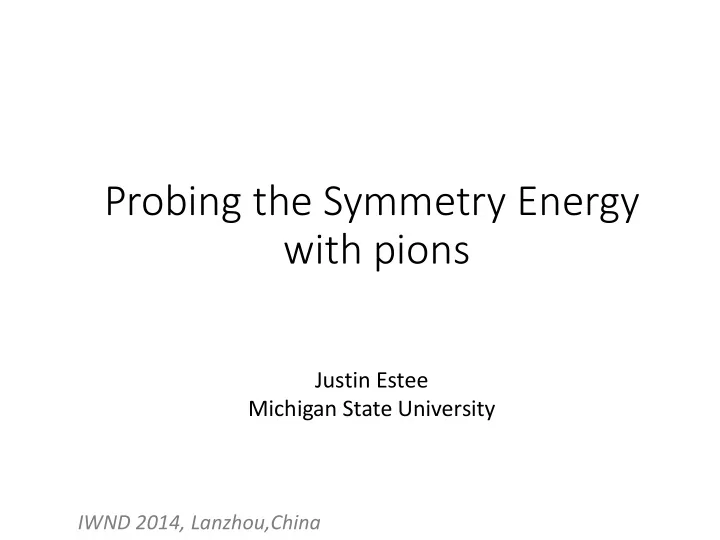

Probing the Symmetry Energy with pions Justin Estee Michigan State University IWND 2014, Lanzhou,China
Motivation for the pion observable • Observables around ~2ρ o important for neutron − ρ o =.16 nucleons/fm 3
Pion production and Symmetry Energy soft soft stiff Delta resonance reactions stiff 𝑞𝑞 → ∆ ++ → 𝑞𝑜𝜌 + - / + nn → ∆ 𝑝 → 𝑞𝑜𝜌 − … ect . t (fm/c) Li et al., Nucl.Phys. A734 (2004) 593. • Dominant mode of production is through delta resonances • In delta resonance model, Y( - )/Y( + ) ( n, / p ) 2 • On average stiff symmetry expels more neutrons, less 𝜌 − • High energy pions are of particular interest • Produced early at high density • Less likely to scatter and exchange charge
Transport equation • BUU semi-classical equation governing the dynamics of phase space volume including collisions Local velocity Force from Mean field • L.H.S. of equation describes motion through mean field. R.H.S. describes collisions • and are the feeding and removal rates of particles.
BUU by Danielewicz (pBUU) • pBUU uses simple parameterization of symmetry energy. ε = 𝜁 𝜍, 𝜀 = 0 + 𝑇 𝜍 ∙ 𝜀 2 𝜀 = 𝜍 𝑞 − 𝜍 𝑜 ) 𝜍 • Stiff and soft symmetry energy dependence refers to larger and smaller 𝛿 respectively • In this simulation pions are coupled not only through Coulomb interaction but also isospin. • This isospin coupling is described by the pion optical potential 𝜍 𝑈 ~ 𝜍 𝑞 −𝜍 𝑜 is isospin density 2
First Experiments to be done with S iRIT TPC • Radioactive beams produced at RIKEN • 132 Sn(beam) + 124 Sn(target), neutron rich • 108 Sn(beam)+ 112 Sn(target), neutron deficient • E/A = 300MeV/A • Perform pBUU simulations with several impact parameters and gammas.
- & + spectra; 124 Sn 132 132 Sn+ 124 Sn and b=3fm • Difference in - & soft soft + , due to stiff resonance model stiff • Stiffer symmetry energy, 𝛿 = 1.75 , tends to expel neutrons more than 𝛿 = .5 • + peak at ~ 50 Filled gamma = 1.75 (stiff) Open gamma=0.5 (soft) MeV represents Coulomb peak. KE COM [MeV]
- & + spectra; 108 108 Sn+ 112 112 Sn Sn and b=3fm • Pion yields are similar at high Filled gamma = 1.75 (stiff) Open gamma=0.5 (soft) energy • expected since the system is neutron poor and is closer to isospin symmetry KE COM [MeV]
- / + Ratios 132 Sn+ 124 Sn and b=3fm 108 Sn+ 112 Sn and b=3fm • Coulomb interactions accelerate 𝜌 + and decelerate 𝜌 − boosting ratio at lower K.E., Lowering the ratio at higher K.E. (> 50 MeV) • Sensitivity to the symmetry energy at energies >50 MeV but the effects are small.
New comparison; Subtracted - / + ratio b=3fm R R R 132 124 108 112 132 124 108 112 High energy pions (Better understood) • produced early in high density regions • less likely to be absorbed and exchange charge Low energy pions (less understood) • Pion ratios lack sensitivity in the Coulomb region < 50 MeV • Complicated by Coulomb and pion optical potential effects. • The soft EOS can act opposite to the Coulomb potential.
Summary • Spectral pion ratios are better observables to study symmetry energy • Pions will provide critical constraints in high density regions • High energy pions provide clear sensitivity to different EOS. • The Coulomb and optical potential effects may mask the sensitivity in the low energy pions.
Thank you! • Special thanks to Pawel Danielewicz and Jun Hong • Betty Tsang, Bill Lynch, Bec Shane.
Recommend
More recommend